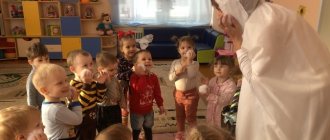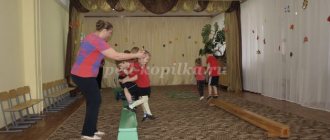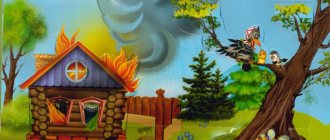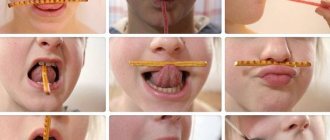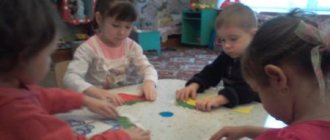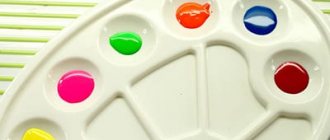Junior group. Early childhood, nursery. Children 1-4 years old
Summary of physical education “Visiting Winter” with young children
Target . To form a positive attitude in children towards physical education activities . Create an emotionally positive attitude. Tasks . Improve the skills of basic types of movements: running, walking, throwing, climbing. Give children ideas about seasonal changes in nature...
Summary of educational activities on cognitive, speech and physical development for children 2–3 years old “Let's teach a doll to wash” TOPIC: “LET'S TEACH A DOLL TO WASH”
Goal: to introduce a healthy lifestyle and consolidate cultural and hygienic skills in young children using a didactic doll. Objectives: 1. Educational. -promote the formation of cultural and hygienic skills in children;…
Card index “Physical education in the second junior group”
Abdulova Dzhume Sirazhutdinovna
Card index “Physical education in the second junior group”
Lesson 1
Tasks. Practice walking between objects, running in all directions; in maintaining stable balance when walking on increased support; in jumping.
Part 1. Walking in a column one at a time; walking between objects (cubes, skittles placed along the hall; the distance between them is 1 m. Children in a column, one at a time, walk between objects in a “snake” manner. When the last child in the column passes between the objects, the command is given to run in all directions. The task is repeated twice.
Part 2. General developmental exercises with a hoop.
1. I. p. – feet at the width of the foot, hoop with a grip from the sides, below. Raise the hoop up, look out the “window”, lower the hoop down, return to the starting position (5 times).
2. I. p. – standing with feet hip-width apart, hoop in bent arms near the chest, grip of arms from the sides. Sit down, bring the hoop forward, rise, return to the starting position (4 times).
3. I. p. - feet shoulder-width apart, hoop in bent arms near the chest. Raise the hoop up, lean to the right (left); straighten up, return to the starting position (2-3 times).
4. I. p. - standing in a hoop, legs slightly apart, hands on the belt. Jumping on two legs in a hoop, alternating with a short pause.
Main types of movements.
Equilibrium. Walking on the board sideways with an extended step, hands on the belt, at a moderate pace. At the end of the bench, step down and step forward. The teacher provides assistance and insurance (2-3 times).
Jumping from bump to bump. Along the opposite sides of the hall there are 5-6 hoops at a distance of 50 cm from one another in a checkerboard pattern. After the teacher shows and explains the task, the children line up in two columns and perform jumps from hoop to hoop in a continuous manner. The teacher makes sure that the children push off energetically from the floor and land on bent legs, maintaining the required distance.
Outdoor game "Hen and Chicks".
3rd part. Game "Let's find the chicken."
Lesson 2
Tasks. Exercise walking with stepping, developing coordination of movements; repeat tasks in jumping and throwing a ball.
Part 1. Walk in a column one at a time, stepping over the cords with your right and left feet alternately. The cords are placed at a distance of 30–35 cm from one another (child’s step). The main thing is that there are no extra steps. Then the command is given to run in all directions, using the entire area of the hall.
Part 2. General developmental exercises.
1. I. p. - legs at the width of the foot, arms along the body. Raise your arms up to your sides, clap your hands above your head; lower your arms, return to the starting position (9 times).
2. I. p. - feet width apart, hands behind the back. Sit down, clap your hands in front of you; straighten up, return to the starting position (4 times).
3. I. p. – feet shoulder-width apart, arms to the sides. Tilt to the right, touch your right leg with your palm, straighten up, arms to the sides. The same to the left (4–5 times).
4. I. p. - feet shoulder-width apart, hands on the belt. Turn to the right, arms to the sides; return to the starting position. The same to the left (3 times).
5. I. p. – legs slightly apart, arms at random. Jump on two legs with a turn to the right, return to the starting position. The same to the left (3-4 times).
Main types of movements.
Jumping "Across the Ditch" In the hall, on both sides of the cords there are 4–5 “grooves” (30 cm wide), one parallel to the other. Children in two columns perform jumps on two legs from “groove to groove”: waving their arms, they energetically push off from the floor and land on half-bent legs.
The exercise is repeated 2-3 times.
Funny Ball Throwing. After performing the jumps, the children take one ball from the box (basket). The children stand in a semicircle, or in two ranks, or randomly throughout the hall. The teacher shows and explains the exercise: “Feet shoulder-width apart, ball in bent arms near the chest. You need to throw the ball at the toes, catch it with both hands after bouncing off the floor, trying not to press it to your chest.” Children take their starting position and throw balls at a signal. After all the children have caught the balls, the signal is given for the next throw. The exercise is repeated 8-10 times.
Outdoor game “Birds in nests”.
3rd part. Walking in a column one at a time.
Lesson 3
Tasks. Practice walking and running in a circle, turning at a signal; repeat rolling balls, developing dexterity and eye; crawling in a straight line.
Part 1. Walking and running around the cubes with a turn in the other direction at the teacher’s signal (cubes according to the number of children). After walking and running exercises, the teacher invites each child to take a cube. Formation in a circle.
Part 2. General developmental exercises with a cube.
1. I. p. – legs at the width of the foot, cube in the right hand below. Raise your arms up through your sides, transfer the cube to your left hand, lower your hand. The same with the left hand (3-4 times).
2. I. p. – feet shoulder-width apart, cube behind back in right hand. Bend over, put the cube on the floor, straighten up; bend over, take the cube in your left hand, straighten up. And so on alternately (4 times).
3. I. p. - sitting, legs crossed, cube in right hand. Turn to the right, place the cube at the toes; straighten up, hands on your waist. Turn to the right, take the cube, transfer it to your left hand. The same to the left (3 times).
4. I. p. – legs slightly apart, arms at random, cube on the floor. Jumping on two legs around the cube in both directions (2-3 times).
Main types of movements.
“Ride between objects.” Rolling balls between medicine balls (4-5 pieces, lying at a distance of 1 m from each other. The ball moves like a “snake” between objects - children push it with two hands folded in a “boat”. At the end of the exercise, you need to take the ball in your hands and lift it over your head and stretch.
Crawling in the forward direction “Funny Bugs”. Crawling on a gymnastic bench on your hands and knees - fast, like bugs. It is performed in-line in two columns (2–3 times).
Outdoor game "Frogs".
3rd part. Walking in a column one at a time.
Lesson 4
Game exercises on the covered and mastered material.
1. "Beetles." At the teacher’s signal: “The beetles have flown!” - the children scatter all over the hall. At the signal: “The beetles are resting,” the children lie on their backs and move their legs and arms, as if moving their paws. Then the “bugs” fly again and rest (you can use musical accompaniment).
2. "Ride - catch." Children are divided into threes and take their starting position - sitting, legs apart. In the hands of one of the players is a ball of large diameter. At the signal: “Let’s go!” – children take turns rolling the ball to each other.
3. Outdoor game “Find your color.”
Summary of a physical education lesson in the junior group
Notes on physical education in the junior group on the topic “Playing with a bear”
Author: Natalya Vladimirovna Kotlyarova, teacher of MBDOU No. 185 “Golden Grain, Nizhny Tagil.
Description of the material: I offer you a summary of a physical education lesson for children of the younger group (3-4 years old) on the topic “Playing with Mishka.” This material will be useful for primary care teachers and physical education teachers. Synopsis of a game-based role-playing physical education lesson for children 3-4 years old. We play with a bear. Types of children's activities: gaming, communication, cognitive-research, musical and artistic. Objectives: Educational: teach jumping on two legs across a line; strengthen walking and running skills; the ability to maintain balance when walking in a limited area. Educational: respectful attitude towards each child and children towards each other; discipline in completing tasks. Developmental: development of attention and observation. Planned results: actively and kindly interact with the teacher and peers in solving gaming and cognitive problems; adequately perceives the teacher’s comments; performs running and jumping according to safety rules. Equipment: toy bear, “stream” (2 ropes 2 m long with a distance of 50 cm between them), 6 pins, 4 flat hoops (diameter 25 cm), ball (diameter 20 cm), cones according to the number of children. Progress of the lesson. Children enter the hall and line up in one line. Instructor. Guys, guess the riddle: He sucks his paw, Oh, that’s how spring comes, Wakes up from sleep And let’s roar in the forest…. Everyone calls him... (bear). That's right, it's a bear. A teddy bear came to visit us today and brought with him a whole basket of pine cones. We will play with him, run, jump and gallop. Let's first show the bear how we can walk beautifully. Walking one after another. Now let's show how fast we are. Run. And now how clever and strong we are. Everyone stand in a circle. Now the bear will give each of you a bump. And we will show him exercises with cones. Cones fall from the pine tree, we must pick up the cone. I.p. - feet shoulder-width apart, hands with a bump at the bottom. B: 1- raise your arms up, stretch, release the lump from your hand, sit down, take the lump, 4- straighten up. (repeat 4 times) The cone rolled under the bush and lay there quietly, hiding. IP - sitting, legs apart, hands with a teddy bear on your lap. B: 1-2 - lean forward (try not to bend your knees), put the cone between your legs, 3-4 - straighten up, clap your hands, 5-6 - lean forward, take the cone, 7-8 - straighten up, lift the cone up. (repeat 4 times) I need to play with the cone, I’m tired of it lying there. I.p. - lying on your back, a lump in both hands above your head. B: 1-2- raise your legs up, arms up and forward, touch your feet with your cone, 3-4- i.p. (repeat 4 times) Cones love to play, play pranks and jump around. IP - legs together, bump in one hand. B: jumping in place (20-30 sec) Well done, guys! Bear really liked your exercises with pine cones. But you know, the bear secretly told me that he doesn’t know how to cross the road at all. Let's teach him how to cross the road correctly. 1. “Cross the road.” - Look left, look right, cross the road one after another. Walking one after another along the “stream” with turning your head left and right. (2 times) 2. “Let’s run” So we came to the park. Let's run a little. Run one after another on tiptoes between pins placed in one line (arms to the sides) (2 times) 3. “Let’s jump” Now let’s teach the bear to jump correctly. Jumping on 2 legs from hoop to hoop, hands on the belt. (2 times) Bear really liked what you were doing, and now he wants to play with the ball. Game "Roll the ball". Children sit on the floor in a circle, legs apart. The instructor (with a teddy bear), holding a ball in his hands, stands in the center of the circle. He rolls the ball to each child in turn. Children catch the ball, then roll it to the bear (instructor). The game is repeated 2 times. Instructor. Well, it's time for the bear to leave. Today we showed the bear how to deal with pine cones, taught him to cross the road correctly, run on his toes and jump. The children wave and leave the hall.
We recommend watching:
GCD summary in the 2nd junior group on the topic “Friends for the Snowman” GCD summary for mathematical development in the first junior group GCD summary for the first junior group on the development of mathematical abilities using ICT Summary of GCD for the development of creative abilities for children of the first junior group
Similar articles:
Summary of educational activities for children of the younger group “Visiting the Fox”
Summary of the integrated lesson “The Adventures of Kolobok” in the junior group
Summary of an integrated lesson in the 2nd junior group
